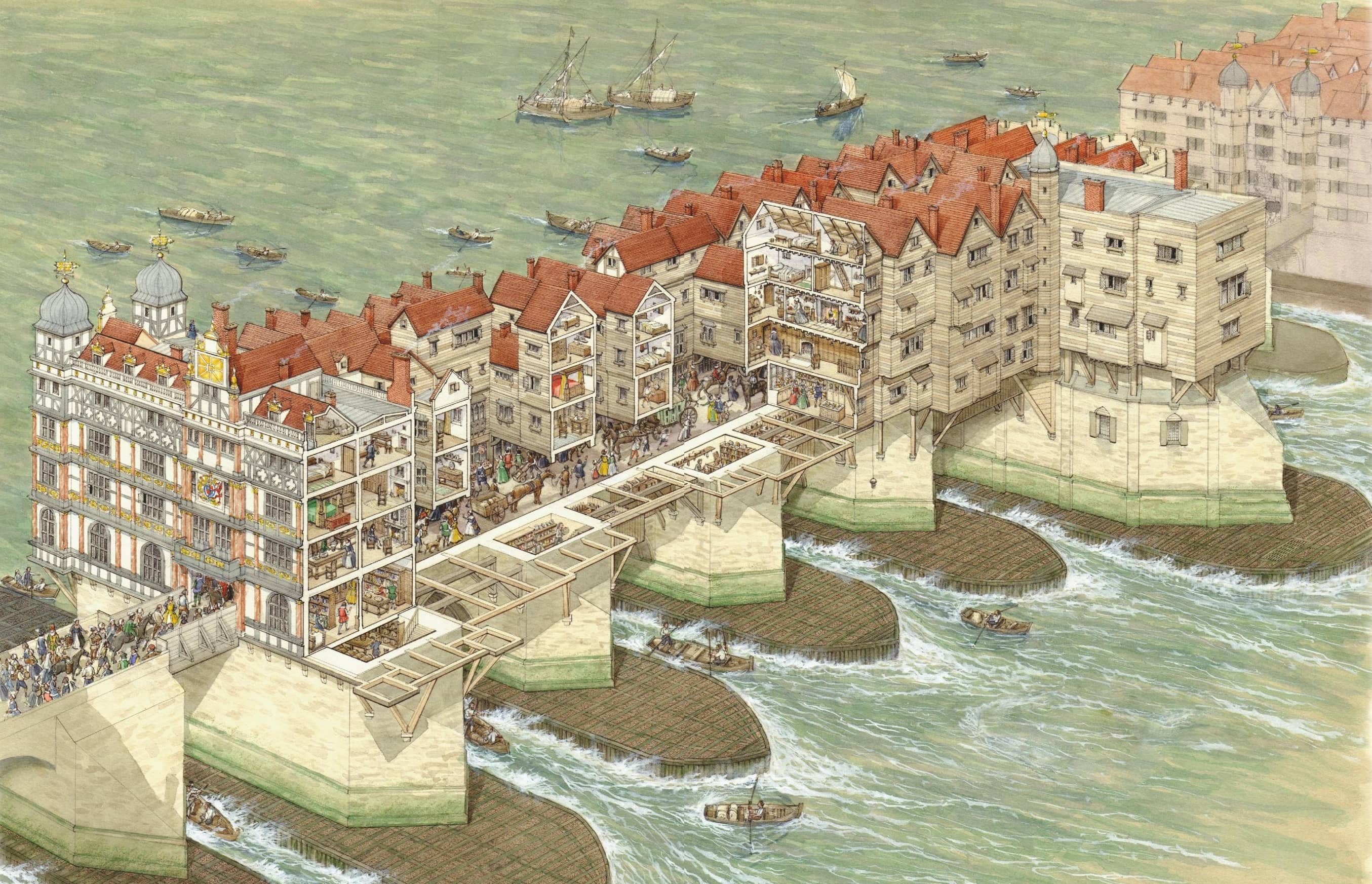
A reconstruction drawing of London Bridge in about 1590 by Stephen Conlin, specially commissioned for Country Life. It shows the middle section of the bridge, with the spectacular façade of Nonsuch House to the left and the medieval chapel, converted into a house, on the large pier to the right. The cutaway shows the arrangement of houses along the bridge, as well as the massive hammer beams laid parallel to the roadway that supported them. Notice the cellars created within the piers or slung beneath the hammer beams. The house interior shown follows the standard plan of ground-floor shop, first-floor hall, second-floor kitchen and chambers and garrets above. Cross buildings spanned the roadway at intervals and created an intermittent tunnel; at least one foreign visitor walked along the street without realising he had crossed a river. Water for the houses was hauled from the river. The enormous starlings restricted the flow of the river and, at low tide, created treacherous shoots of water between the piers. This restricted flow stilled the water upstream of the bridge and made it easier for it to freeze over.
OLD LONDON BRIDGE, lined with rickety-looking wooden houses, was by far the longest inhabited bridge in Europe, with the homes of more than 500 people—the equivalent of a small town—perched above the rushing waters of the Thames. It was also a crucial part of London’s road network, a principal shopping street and much admired by foreign visitors. A Frenchman, L. Grenade, wrote in 1578 that ‘there is no bridge in the whole of Europe which is on a great river like the Thames and as formidable, as spectacular and as bustling with trade as this bridge in London’. He ranked it with St Paul’s Cathedral, the Royal Exchange and the Tower as one of London’s most impressive structures.
This story is from the {{IssueName}} edition of {{MagazineName}}.
Start your 7-day Magzter GOLD free trial to access thousands of curated premium stories, and 9,000+ magazines and newspapers.
Already a subscriber ? Sign In
This story is from the {{IssueName}} edition of {{MagazineName}}.
Start your 7-day Magzter GOLD free trial to access thousands of curated premium stories, and 9,000+ magazines and newspapers.
Already a subscriber? Sign In

Tales as old as time
By appointing writers-in-residence to landscape locations, the National Trust is hoping to spark in us a new engagement with our ancient surroundings, finds Richard Smyth

Do the active farmer test
Farming is a profession, not a lifestyle choice’ and, therefore, the Budget is unfair

Night Thoughts by Howard Hodgkin
Charlotte Mullins comments on Moght Thoughts

SOS: save our wild salmon
Jane Wheatley examines the dire situation facing the king of fish

Into the deep
Beneath the crystal-clear, alien world of water lie the great piscean survivors of the Ice Age. The Lake District is a fish-spotter's paradise, reports John Lewis-Stempel

It's alive!
Living, burping and bubbling fermented masses of flour, yeast and water that spawn countless loaves—Emma Hughes charts the rise and rise) of sourdough starters

There's orange gold in them thar fields
A kitchen staple that is easily taken for granted, the carrot is actually an incredibly tricky customer to cultivate that could reduce a grown man to tears, says Sarah Todd

True blues
I HAVE been planting English bluebells. They grow in their millions in the beechwoods that surround us—but not in our own garden. They are, however, a protected species. The law is clear and uncompromising: ‘It is illegal to dig up bluebells or their bulbs from the wild, or to trade or sell wild bluebell bulbs and seeds.’ I have, therefore, had to buy them from a respectable bulb-merchant.

Oh so hip
Stay the hand that itches to deadhead spent roses and you can enjoy their glittering fruits instead, writes John Hoyland

A best kept secret
Oft-forgotten Rutland, England's smallest county, is a 'Notswold' haven deserving of more attention, finds Nicola Venning